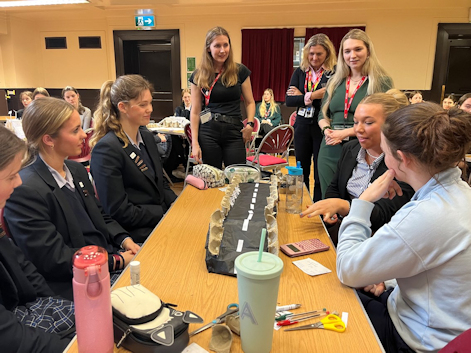
Railway Women
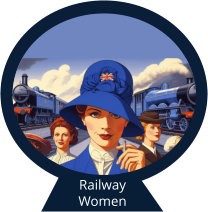
Prelude - Building the railways
Workers and WAGS
Development of the railways in the UK depended on the provision of railway lines and associated infrastructure. The work was undertaken by huge gangs of itinerant labourers known as navvies. At its peak in the 1840s, 250,000 labourers were employed – cutting and tunnelling the first railway network of the industrial age. The navvies were generally men but there is evidence of women also being employed as navvies.
As many navvies had a nomadic lifestyle, their wives and families had to accompany them as they travelled across the country to work on various engineering projects.
The women, often described as kind neighbours, good nurses, who cooked well and sent well-ordered children off to the mission schools, played a significant part in the effort to build the railway network.
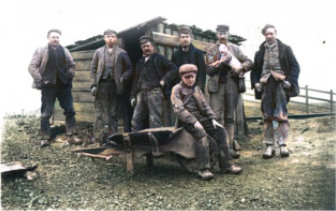
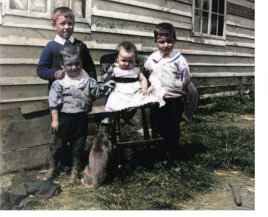
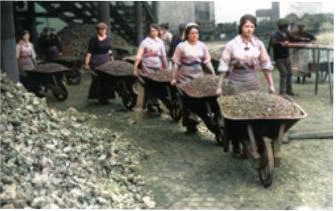
Before 1914
Feminine Propriety
In the early days of the railways women were usually recruited for those roles "that only women could do".
Women's contribution was restricted largely to the likes of cleaning, sewing, cooking and ladies’ room attendants.
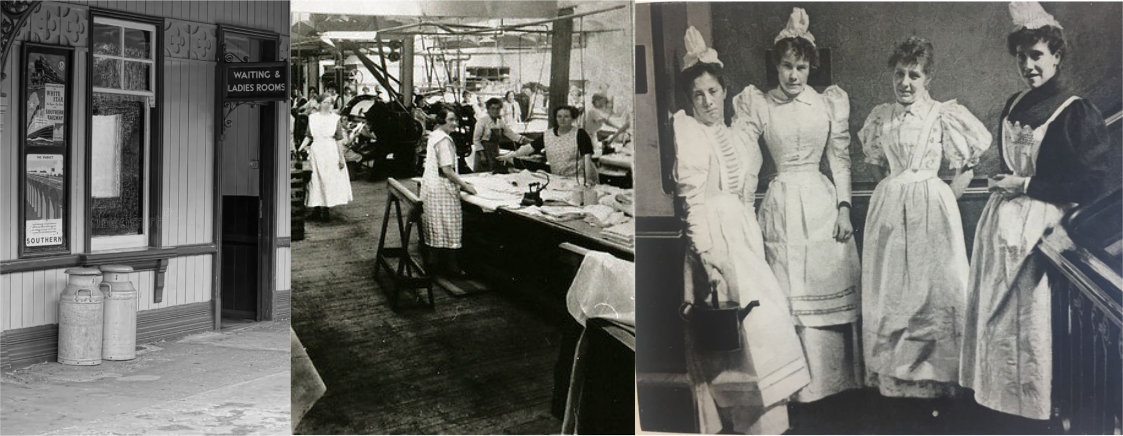
The one area where women were involved with operations was as level crossing gatekeepers. Some women whose husbands or fathers were employees of the railway were afforded the opportunity to become level crossing keepers. This task, often associated with provision of lodgings, was a great responsibility involving safety of the public, passengers and other railway employees.

At this time women were paid up to two thirds less than men. Railway women were also excluded from joining unions.
World War I
Women called to keep the railways running

During the First World War, almost one third of male railway workers joined the armed forces, leaving the country’s railways in crisis. While opposition to women in rail was fierce, and they were restricted in carrying out certain work on the railways, there was a stampede for jobs. The proportion of women working in rail increased from 2% to 66% in four years. By the end of the war in 1918, almost 66,000 women were employed in the rail industry. Half of these women were uniformed, performing manual labour in roles previously considered inappropriate for women.
Women were employed in most railway jobs including:
- booking office
- clerical, telephone and telegraph duties
- employed in stationmasters’ office
- engine cleaners,
- inspectors
- locomotive cleaners
- office clerks
- parcel porters,
- policewomen
- railway guards
- signal box operator
- telegraph office
- ticket collectors
In 1919, the Restoration of Pre-War Practices Act was passed, requiring women to give up their jobs to returning servicemen. Some were retained in their roles, but most were demoted or dismissed.
Between the wars
The railways entered a slow decline owing to a lack of investment and changes in transport policy and lifestyles

Although during WW1 women played a vital role in the railway industry and successfully undertaken most railway jobs the inter war years saw their numbers and status decline. 1918 to 1939 the number of women employed by the railways had fallen by 31,000 from 56,000 to 25,000. In 1919, the Restoration of Pre-War Practices Act was passed, requiring women to give up their jobs to returning servicemen. Some were retained in their roles, but most were demoted or dismissed
- 1921, Railways Act 1921. The majority of the railway companies in Great Britain were grouped into four main companies.
- 1921, the first women’s conference of the National Union of Railwaymen was held in London, attended by about 200 delegates. The conference discussed issues such as equal pay, maternity benefits, and protective clothing for women workers.
- 1923, The grouping took effect from 1 January. Most employees transferred to one of the 'Big Four' railway companies.
- Great Western Railway (GWR)
- London, Midland & Scottish Railway (LMS)
- London, North Eastern Railway (LNER)
- Southern Railway (SR)
- 1926, the General Strike saw thousands of railway workers join the nationwide protest against wage cuts and unemployment. Women played a vital role in supporting the strikers, by organising food, funds, and solidarity. Some women also took part in the strike themselves, or joined the Women’s Councils for the Defence of Trade Unionism.
- 1931, the first women’s magazine for railway workers was launched, called The Railwaywoman. The magazine featured articles on topics such as health, fashion, travel, and hobbies, as well as news and views from women in the industry.
- 1936, the first women’s hostel for railway workers was opened in London, providing accommodation and facilities for women who had to travel long distances to work. The hostel was run by the Railway Women’s Guild, which also operated a holiday home and a convalescent home for women workers.
World War II
Women called to keep the railway on track, again
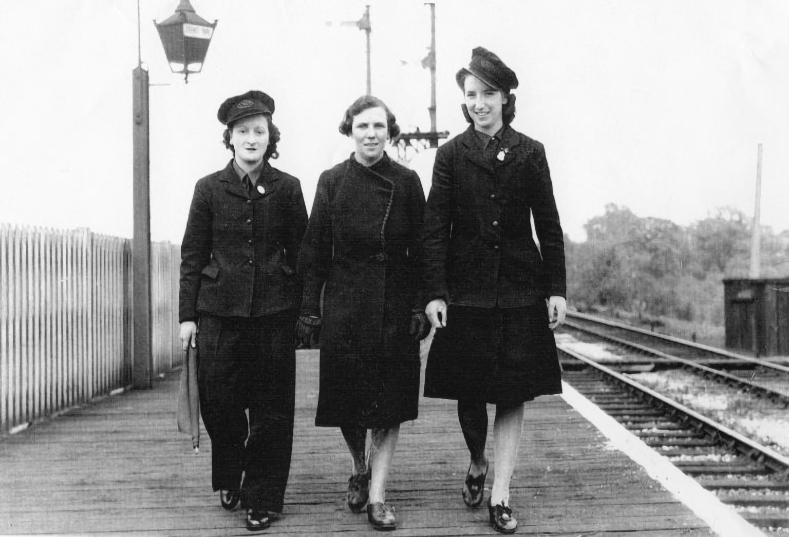
They’ve taken over a man’s job and they do it without any fuss,
So next time you travel, next time you read of troops going abroad
Or tanks being shipped to the middle east or Russia.
Next time you hear of a railway that was working again six hours after a blitz,
Think of the women behind the scenes who keep the rolling stock rolling. British Pathé.
1939, The outbreak of the Second World War led to another wave of women being recruited to the railways, as men were called up for military service. Women worked as porters, guards, signalwomen, permanent way workers and undertook many other roles.
1941, The first women took over signal duties on Britain's mainline railways
1942, Betty Chalmers was working on the switchboard at LNER York Station when the station was bombed. She had to move to a replacement switchboard in a corridor under the bar walls, in hot, unventilated conditions, while colleagues at the station were clearing out broken glass and sorting wet tickets
1943, Women were being put in charge of trains along the south coast, midlands and London. While the railways across the country were under attack, these tracks in particular, suffered from heavy bombings, and the work being carried out was both extensive and dangerous
1945, By the end of WWII, the number of women in railway jobs had increased from 635 in 1939 to 10,899 in 1945
1945, 35,000 women who had taken men's roles during the war were dismissed.
"Goodbye to you, ladies, and good luck go with you. You have done a good job of work and you leave the service of the L.N.E.R. with the knowledge that you have been of invaluable assistance to the country's war effort and your work has been appreciated by the Company. Many of you have tackled jobs which only men did before the war, and you have succeeded splendidly. You will be long remembered"
Communal letter published in company magazine
Modern times
Towards Equality

1948, Big Four, railway companies were nationalized to form British Railways.
1950s – 1960s, The railway system faced declining passenger numbers and financial losses, which led to the closure of many branch and main lines, and small stations, under the Beeching Axe.
1960s - 1970s, Sex discrimination legislation made it possible for women to be employed in any railway role on the same terms as their male counterparts.
1978, Karen Harrison becomes first woman in Britain to be appointed as a train driver.https://www.bluebell-railway-museum.co.uk/services_files/karenHarrisonPoster.jpg" class="img-fluid mx-auto d-block shadow" alt="Karen Harrison Poster"
2023, 16% of railway employees are women. 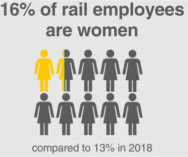
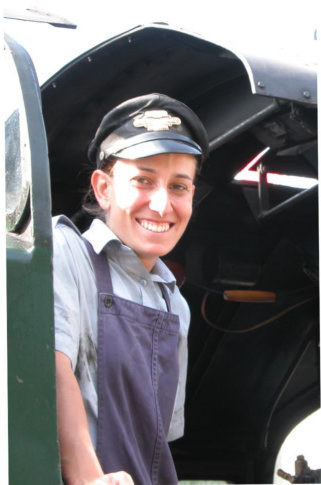
2024, Network Rail hosts careers event to inspire the next generation of women in rail for International Women’s Day. 